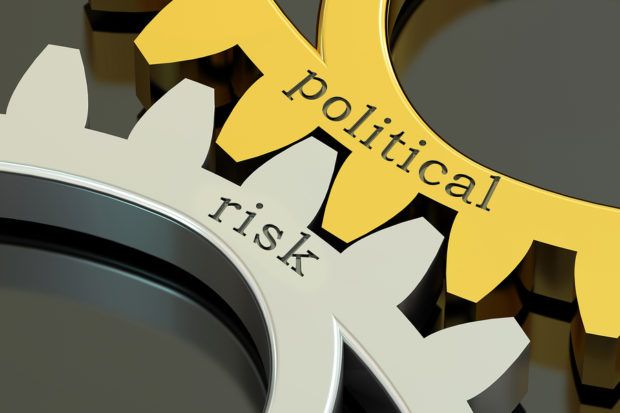Property/casualty insurers head into 2022 facing “massive” political risks, an expert with the Insurance Information Institute said on Dec. 2. Economic uncertainty will also continue despite recovery trends.
Some exist due to post-pandemic economic fallout, but many others are longstanding or worsening flashpoints in the U.S. and around the globe, noted Michel Leonard, vice president, senior economist and data scientist, and head of the Economics and Analytics Department at III. He spoke during the III Joint Industry Forum 2021 in New York City.
Those risks, when listed together, are substantial. In the U.S., they include labor dislocation and the midterm elections, the continued institutional deadlock in Congress, worsening socioeconomic inequality, and far-right domestic radicalization. In the U.S. and around the world, these risks encompass anti-vax radicalization relating to the COVID-19 vaccines, far-left industrial sabotage relating to fossil fuels, and conflict with China over Taiwan and Hong Kong. Other flashpoint risks remain or are worsening in North Korea, Ukraine, Belarus, Latvia, India, China and Pakistan, Leonard noted.
Beyond that, there’s also risks involving weaponized trade policies, state-sponsored cyber terrorism and warfare, and risks involving state and non-state interference in elections both in the U.S. and abroad.
Immediate Problems
More immediately, economic risks remain as the U.S. and world struggle to recover from disruption caused by the coronavirus pandemic, including inflation caused by supply chain disruptions and labor shortages.
Leonard said economic improvement will continue in 2022 as the economy begins to normalize and core inflation and transitory inflation on goods and services subsides. But it will take at least two more years to return to normal growth trends.
“We had a strong year, but we’re still behind in terms of growth,” Leonard said. “You can’t have runaway inflation and growth.”
He added that goods subjected to supply chain delays will take at least two more years to correct, as well as labor shortages.
Still, as Leonard noted, the P/C insurance industry performance is in line with past behavior during recoveries.
“We actually lag a bit when we emerge from a recession,” Leonard said.
In this case, here’s why: As strong as the P/C insurance industry’s 2021 growth was, it was “insufficient” to fully make up for the pandemic contraction, Leonard explained.
COVID could still cause problems, he noted. A resurgence of the virus could push recovery into 2024-2025, he added.
Not the Same Market
So far, the economic recovery has been uneven in the U.S., with broken supply chains and a dislocated workforce causing a drop in construction completion and motor vehicle sales. That will continue into 2022, Leonard said, which means insurers won’t be selecting business with a primary focus on geography.
Expectations are that there will be “blockbuster growth” in 2022-2023 for the construction and auto sectors, once supply chain and labor disruptions subside. That will create both opportunity and pressure for insurers as they adapt to changing conditions.
Moving ahead, Leonard cautions that inflation will no longer be an accurate economic barometer on its own as insurers consider their underwriting priorities.
When planning for inflation, Leonard said goods must now be divided between those made domestically and products coming from overseas. Distribution challenges have changed price increase trends for both, favoring those produced domestically. As well, supply chain and labor disruptions will permanently change how the consumer price index factors as well as insurance replacement costs, he added.
As well, there is a big divide emerging in individual states, where rural areas see lower inflation and urban locales face higher price hikes. This will continue, Leonard said, complicating the climate for insurers as they calculate risks and pricing involved.





















 Breaking: Andersen to Replace Zaffino as CEO of AIG on June 1
Breaking: Andersen to Replace Zaffino as CEO of AIG on June 1  NOAA Announces Latest AI-Driven Global Weather Models
NOAA Announces Latest AI-Driven Global Weather Models  Nearly Half of 100 Largest P/C Insurers Destroy Value: ACORD
Nearly Half of 100 Largest P/C Insurers Destroy Value: ACORD 








